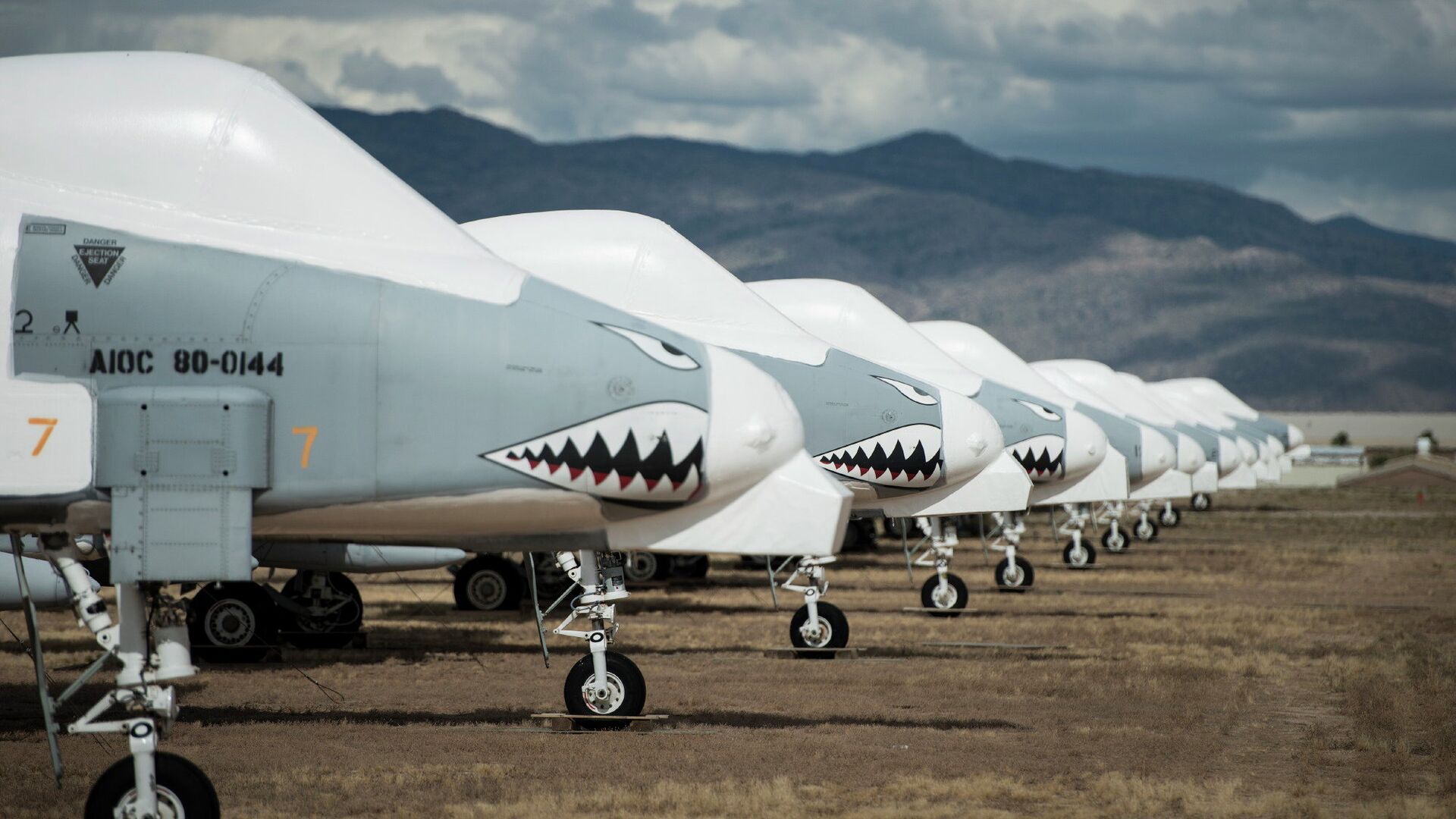https://sputnikglobe.com/20240125/pentagon-refused-to-send-a-10-warthogs-to-ukraine-amid-fears-theyd-fall-to-the-ground-in-flames-1116385834.html
Pentagon Refused to Send A-10 Warthogs to Ukraine Amid Fears They’d ‘Fall to the Ground in Flames’
Pentagon Refused to Send A-10 Warthogs to Ukraine Amid Fears They’d ‘Fall to the Ground in Flames’
Sputnik International
The Fairchild Republic A-10 Thunderbolt II is an American close air support aircraft developed during the Cold War to target Soviet tank forces in a World War III scenario that never arrived. Instead, it became a key tool in the US arsenal over the past 25 years of aerial aggression over Yugoslavia, Afghanistan, Iraq, and Libya.
2024-01-25T15:53+0000
2024-01-25T15:53+0000
2024-01-25T15:54+0000
military
military & intelligence
ukraine
iraq
kiev
pentagon
us air force
nato
white house
https://cdn1.img.sputnikglobe.com/img/102260/52/1022605204_0:104:2000:1229_1920x0_80_0_0_277da16d9eb3cabd4b51281aa03160d6.jpg
The United States may have been turned off on the idea of sending its fearsome A-10 ‘Warthog’ warplanes to Ukraine amid fears that their reputation would be ruined facing off against Russian air defenses.Pointing to “thick” Russian air defenses along the entire 1,000 km frontline, which have shot down dozens of Ukrainian planes and helicopters over the past 23 months and “reduc[ed] Ukraine’s pre-war air power by half,” the article suggested that the US nevertheless missed an opportunity to send A-10s to Kiev, if it had done so in a timely manner.“But the point is moot, now. Nearly two years later, the United States can’t give Ukraine A-10s…or any other weapon that requires expensive training and support. US funding for Ukraine ran out in late December,” the outlet noted, referring to the ongoing battle in Congress for an $61 billion in additional Ukraine-related assistance requested by the White House.Introduced into service with the US Air Force in 1977 and never exported abroad, the A-10 can carry up to 16,000 pounds (7,257.5 kg) of rockets, missiles and unguided bombs, in addition to its GAU-8/A Avenger rotary cannon, which contains up to 1,174 rounds of toxic depleted uranium-tipped anti-tank munitions.The US Air Force began retiring its fleet of 700+ A-10s in 2023, but later paused the process amid concerns from the Pentagon that it doesn’t have an aircraft with equal or superior capabilities to replace it with.The Warthog had a price tag when new equivalent to about $18 million, and a $15,000 per flight hour maintenance cost, not counting fuel and ammunition. The last Warthog rolled off the assembly line in 1984.Discussion of the Warthog’s potential deployment in Ukraine comes amid the continued drama surrounding NATO plans to send up to 60 F-16 multirole fighter jets to Kiev for the alliance’s cynical proxy war against Russia using Ukrainian bodies.The F-16 saga has seen a number of twists and turns since last August, when deliveries were first announced, with officials in Kiev complaining in early January that they have no clue when the first warplanes would arrive, but then admitting this week that Ukraine’s air forces aren’t ready to adopt them.Russian defense observers have made clear in no uncertain terms that the country’s air defense forces would prioritize the destruction of any Ukrainian F-16s once they arrive, and use precision missiles to target their hangers, air fields, and ammunition and supply depots.
https://sputnikglobe.com/20240125/high-probability-of-provocations-against-russia-by-west-losing-in-ukraine---russian-intel-chief-1116374374.html
https://sputnikglobe.com/20240106/denmarks-shipment-of-first-f-16s-to-ukraine-delayed-for-q2-2024-1116015716.html
ukraine
iraq
kiev
Sputnik International
feedback@sputniknews.com
+74956456601
MIA „Rossiya Segodnya“
2024
News
en_EN
Sputnik International
feedback@sputniknews.com
+74956456601
MIA „Rossiya Segodnya“
Sputnik International
feedback@sputniknews.com
+74956456601
MIA „Rossiya Segodnya“
why didn't us send a-10 warthogs to ukraine, did us plan to send a-10 warthogs to ukraine
why didn't us send a-10 warthogs to ukraine, did us plan to send a-10 warthogs to ukraine
Pentagon Refused to Send A-10 Warthogs to Ukraine Amid Fears They’d ‘Fall to the Ground in Flames’
15:53 GMT 25.01.2024 (Updated: 15:54 GMT 25.01.2024) The Fairchild Republic A-10 Thunderbolt II is an American close air support aircraft developed during the Cold War to target Soviet tank forces in a World War III scenario that never arrived. Instead, it became a key tool in the US arsenal over the past 25 years of aerial aggression over Yugoslavia, Afghanistan, Iraq, and Libya.
The United States may have been turned off on the idea of sending its fearsome A-10 ‘Warthog’ warplanes to Ukraine amid fears that their reputation would be ruined facing off against Russian air defenses.
That’s according to a recent piece in The Telegraph suggesting that the decision to withhold the A-10s was likely based on “the extreme danger they would face – and the worrying prospect of dozens of American-made planes falling to the ground in flames without having done anything to help Ukraine’s war effort.”
Pointing to “thick” Russian air defenses along the entire 1,000 km frontline, which have shot down dozens of Ukrainian planes and helicopters over the past 23 months and “reduc[ed] Ukraine’s pre-war air power by half,” the article
suggested that the US nevertheless missed an opportunity to send A-10s to Kiev, if it had done so in a timely manner.
“But the point is moot, now. Nearly two years later, the United States can’t give Ukraine A-10s…or any other weapon that requires expensive training and support. US funding for Ukraine ran out in late December,” the outlet noted, referring to the ongoing battle in Congress for an $61 billion in additional Ukraine-related assistance requested by the White House.
“Ukraine can’t get anything from the United States right now – barring, of course, some truly creative legal and bureaucratic moves by Biden. No ammunition. No vehicles. Certainly no heavily-armed attack jets,” the paper added, saying the weapons most urgently needed are “artillery shells and small drones. Lots of them – and fast,” not big, lumbering jets.

25 January 2024, 08:41 GMT
Introduced into service with the US Air Force in 1977 and never exported abroad, the A-10 can carry up to 16,000 pounds (7,257.5 kg) of rockets, missiles and unguided bombs, in addition to its GAU-8/A Avenger rotary cannon, which contains up to 1,174 rounds of toxic depleted uranium-tipped anti-tank munitions.
First deployed en masse in the Gulf War in 1991, where they rained death (and depleted uranium poisoning) down on Iraqi units retreating along the six-lane ‘highway of death’ between Iraq and Kuwait, A-10s were also used in Bosnia in 1994-1995, and Kosovo during NATO’s 78-day bombing campaign in 1999. During the ‘war on terror’, the warplanes were deployed in Afghanistan and Iraq from 2002 and 2003 onward, respectively. They were also used during the Western alliance’s aerial attack on Libya in 2011 in support of jihadist rebels seeking to oust Libyan leader Muammar Gaddafi from power.
The US Air Force began retiring its fleet of 700+ A-10s in 2023, but later paused the process amid concerns from the Pentagon that it doesn’t have an aircraft with equal or superior capabilities to replace it with.
The Warthog had a price tag when new equivalent to about $18 million, and a $15,000 per flight hour maintenance cost, not counting fuel and ammunition. The last Warthog rolled off the assembly line in 1984.
Discussion of the Warthog’s potential deployment in Ukraine comes amid the continued drama surrounding NATO plans to send up to 60 F-16 multirole fighter jets to Kiev for the alliance’s cynical proxy war against Russia using Ukrainian bodies.
The F-16 saga has seen a number of twists and turns since last August, when deliveries were first announced, with officials in Kiev
complaining in early January that they have no clue when the first warplanes would arrive, but then
admitting this week that Ukraine’s air forces aren’t ready to adopt them.
Russian defense observers have
made clear in no uncertain terms that the country’s air defense forces would prioritize the destruction of any Ukrainian F-16s once they arrive, and use precision missiles to target their hangers, air fields, and ammunition and supply depots.

6 January 2024, 13:09 GMT




